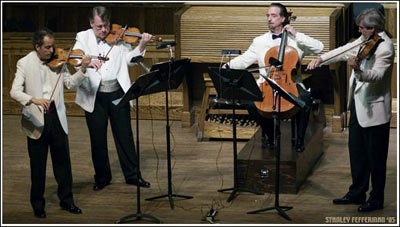 |
|
2005 Ottawa International Chamber Music Festival
|
The Emerson String Quartet Play Mendelssohn and Beethoven
by Stanley Fefferman |
|
|
| Mendelssohn’s String Quartet No.1 in E-flat major, Op. 12 emits waves of rhapsodic feeling. Feeling, and form provided by definite strokes from the lower register strings, set the piece sailing like a masted schooner out of the bay. Mendelssohn’s exquisite, plaintive melodies aspire, through repetition and variation, to let the story of a personal journey be heard. |
| In the earlier movements, the solo voice of Philip Setzer’s first violin enunciates the themes that are echoed by the ensemble. In the final movement, the violins speak more in concert; the darker tonal background of David Finckel’s cello and Lawrence Dutton’s viola mollifies the soaring tones of the violins in their striving to be heard. The piece eases into rest on a silence like the shoreline of home. |
|
 |
|
Mendelssohn’s third String Quartet, the D major, Op. 44, No.1 is firmer and more mature in tone, more declamatory, less plaintive, but still quite visceral and capable of drama and passion. There is a feeling of lighthearted serenity, especially in the second, slow movement in passages where the cello takes up the theme. In the short third movement you can hear traces of Jewish melodies integrated into a confident and moderated environment. The sense of civility is emphasized in the briskly structured fourth movement.
Where Mendelssohn’s work resolves a dialogue between the personal and the civil, Beethoven’s late Quartet, No. 15 in A minor, Op. 132, is like a Mardi Gras celebration where anything and everything can happen. It is like a cathedral, built over a period of centuries with tapestries and banners of sound fluttering in the wind above and around a riot of architectural masses: towers, buttresses, spires, crenellations, sculpture, bas relief and filigree juxtaposed and counterpoised between deep bass tones of the moat and the cries of birds in flight.
There is a particularly magical sequence in the slow third movement where the solo voice of Eugene Drucker's first violin, sounding like a bagpipe, utters a stately farewell that is developed by the ensemble as planes of sound successively receding, vanishing into the horizon, arising again from silence, and vanishing finally into an awesome void.
The Emerson tone is solid, smooth, rich and whole, like good wood. Their sense of time is perfect and they possess the marvelous ability to sound like a single instrument.
|
|
|
|
We welcome your comments and feedback
|
| Stanley Fefferman |
• • • • • •
|
|
| for The Live Music Report |
• •
|
|
|
•
|
|
|
|
|


